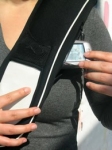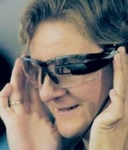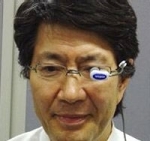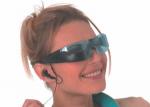Mar 26, 2006
Textually: Small screens a contributing factor to visual fatigue
 Studies have found that the majority of people who work at a computer experience some eye or vision problems, and that the level of discomfort appears to increase with the amount of computer use, reports medical news today . "But, increased use of smaller, portable work and recreational gadgets such as PDAs, laptops and cell phones may also be contributing factors to the visual fatigue and discomfort experienced by millions, according to leading expert, Dr. Jeffrey Anshel."
Studies have found that the majority of people who work at a computer experience some eye or vision problems, and that the level of discomfort appears to increase with the amount of computer use, reports medical news today . "But, increased use of smaller, portable work and recreational gadgets such as PDAs, laptops and cell phones may also be contributing factors to the visual fatigue and discomfort experienced by millions, according to leading expert, Dr. Jeffrey Anshel."20:23 Posted in Wearable & mobile | Permalink | Comments (0) | Tags: Positive Technology
Mar 15, 2006
Wrist-mounted PC
 "A European embedded computing specialist has announced a wrist-worn wearable computer that runs embedded Linux or Windows CE. Eurotech's WWPC ("wrist-worn PC") offers a wealth of standard PC interfaces, along with several innovative wearable-specific features, the company claims. It targets emergency rescue, security, healthcare, maintenance, logistics, and "many other" applications."
"A European embedded computing specialist has announced a wrist-worn wearable computer that runs embedded Linux or Windows CE. Eurotech's WWPC ("wrist-worn PC") offers a wealth of standard PC interfaces, along with several innovative wearable-specific features, the company claims. It targets emergency rescue, security, healthcare, maintenance, logistics, and "many other" applications."
20:03 Posted in Wearable & mobile | Permalink | Comments (0) | Tags: Positive Technology
Mar 02, 2006
Scientist Brings Life to Cell Phones
Via Networked performance (from the original posting by Jim Downing on Smart Mobs]
Samsung Electronics "is now cooperating with a local research team to develop cell phone software that can feel, think, evolve and reproduce", the Korea Times reports. "The team, led by Prof. Kim Jong-hwan at the Korea Advanced Institute of Science and Technology, is hooking up with Samsung to create the attention-grabbing software outfitted with "artificial chromosomes". "This software can feel, think and interact with phone owners.It will breathe power into cell phones, bringing the gadgets to life,'' Kim said. 'We have almost completed the first-stage task with Samsung to install the software in cell phones and plan to start the second job soon,'' the 48-year-old said. Oh's former top lieutenant Lee Kang-hee said a three-dimensional avatar will lurk inside the cell phone and adjust itself to characteristics of the cell phone carriers. 'It's just like a sophisticated creature living inside a cell phone.An owner will be allowed to set its first personality by defining the underlying DNA,'' said Lee, who will join Samsung Electronics tomorrow."
However, it is up to the avatar how its personality develops with the owner. Its personality can get better or worse depending on how people treat it,'' he said. Lee added folks will be able to deal with loneliness felt by the avatar, which will pop up on the phone when they feel alone, by touching a button. Should the owner refuse to respond to the signal, the avatars will change their personalities either to express such feelings more often or just to become depressed,according to Lee. This year,the team is poised to start enabling the cell phone-embedded artificial creature to mate with another to have offspring".
13:35 Posted in Wearable & mobile | Permalink | Comments (0) | Tags: Positive Technology, mobile
Mar 01, 2006
Mobile guitar-phone
Via Textually.org
Motorola is patenting a mobile phone that allows users to play a "virtual guitar neck" displayed on the screen by using its keypad; the produced sound can be played through the device's speaker or communicated at distance

22:28 Posted in Wearable & mobile | Permalink | Comments (0) | Tags: Positive Technology
Feb 19, 2006
IST Mobile Summit 2006
IST Mobile Summit 2006 is taking place 4-8 June 2006, in Myconos, Greece
The Summit will distribute the latest information covering all aspects of wireless telecommunications for systems of present and future generation to managers, researchers, hardware/software designers and other professionals in the field. The conference will also cover policy, regulation and standardisation issues, which have a key role in the introduction of operative systems and services. The conference will include invited presentations from leading experts. Several demonstrations from European and International projects will also take place, as well as exhibitions.
Visit the event's web site for more information
14:30 Posted in Wearable & mobile | Permalink | Comments (0) | Tags: Positive Technology, wearable, mobile
Jan 20, 2006
Mobile eyetracking systems
Building a lightweight eyetracker by Jason S.Babcock & Jeff B. Pelz from Rochester Institute of Technology:
![]()
Abstract. Eyetracking systems that use video-based cameras to monitor the eye and scene can be made significantly smaller thanks to tiny micro-lens video cameras. Pupil detection algorithms are generally implemented in hardware, allowing for real-time eyetracking. However, it is likely that real-time eyetracking will soon be fully accomplished in software alone. This paper encourages an “open-source” approach to eyetracking by providing practical tips on building lightweight eyetracking from commercially available micro-lens cameras and other parts. While the headgear described here can be used with any dark-pupil eyetracking controller, it also opens the door to open-source software solutions that could be developed by the eyetracking and image-processing communities. Such systems could be optimized without concern for real-time performance because the systems could be run offline.
20:35 Posted in Wearable & mobile | Permalink | Comments (0) | Tags: Positive Technology
Jan 17, 2006
France Telecom offers "big screen" video Eye Wear

17:51 Posted in Wearable & mobile | Permalink | Comments (0) | Tags: Positive Technology
Jan 16, 2006
Wi-MAN is official
The IEEE has approved the 802.16e specification as the standard to be used for metropolitan area networks.
The new standard has been labeled Wi-MAN, for Wireless Metropolitan Area Network, or WiMAX, for Worldwide Interoperability for Microwave Access. The technology works with existing Wi-Fi networks, enabling users to shift between Wi-Fi and WiMAX connections.
From the press release
The IEEE 802.16 WirelessMAN standard continues its evolution as a platform upon which the broadband wireless industry can build high-performance, cost-effective fixed, and now mobile, broadband access systems,” said Roger B. Marks, Chair of the IEEE 802.16 Working Group on Broadband Wireless Access. “The Working Group’s open consensus process attracted the dedicated participation of hundreds of technical experts from the world's leading service providers, system vendors, and semiconductor suppliers. The foundation for a global industry is now in place.”
21:24 Posted in Wearable & mobile | Permalink | Comments (0) | Tags: Positive Technology
Dec 22, 2005
TOUCH
From the website.
Touch is a research project at the Interaction Design department at the Oslo School of Architecture and Design, looking at user-centred applications for Near Field Communication (NFC). NFC is a technology that enables connections between mobile phones and real-world objects:bridging the gap between the real and the virtual
Touch23:05 Posted in Wearable & mobile | Permalink | Comments (0) | Tags: Positive Technology, mobile
Oct 31, 2005
//MUKANA
Mukana is a wearable wireless device to help the visually impaired, which connects technology with textiles. The system consists of a cell phone, a wireless headset, a Global Positioning System (GPS) module and voice recognition software. Users can ask the system to tell them their location, to give information on what route to take to their destination or on the timetables of public transportation.  The guide system is operated with a Bluetooth® enabled wireless headset and an integrated 10-key Braille number pad for the visually impaired. Extra batteries are included to guarantee the long-term functioning of the system and the cell phone. There is a pocket where the headset can be charged and stored, as well as a pocket for keys and a wallet. The Braille keypad is located in front of the garment, rotated 90 degrees from the normal position to support ergonomic hand movement.
The guide system is operated with a Bluetooth® enabled wireless headset and an integrated 10-key Braille number pad for the visually impaired. Extra batteries are included to guarantee the long-term functioning of the system and the cell phone. There is a pocket where the headset can be charged and stored, as well as a pocket for keys and a wallet. The Braille keypad is located in front of the garment, rotated 90 degrees from the normal position to support ergonomic hand movement.
18:15 Posted in Wearable & mobile | Permalink | Comments (0) | Tags: Positive Technology, wearable
Lost in translation? Get CMU translation goggles
via Engadget
Researchers from the International Center for Advanced Communication Technologies (interACT), a joint venture of Carnegie Mellon and the University of Karlsruhe, have developed a wearable system, which allows real-time speech translation.  The system consists of consists of 11 electrodes that detect mouth muscle movements, translates that to a spoken language, and then re-translates that into other languages. According to comp-sci professor Alex Weibel, director of inteACT, the system still makes mistakes, he is confident that researchers will improve it significantly in the next five years. "It will make communication and cultural learning more likely" since people using this technology will be empowered to come together when they wouldn't otherwise interact, Waibel said.
The system consists of consists of 11 electrodes that detect mouth muscle movements, translates that to a spoken language, and then re-translates that into other languages. According to comp-sci professor Alex Weibel, director of inteACT, the system still makes mistakes, he is confident that researchers will improve it significantly in the next five years. "It will make communication and cultural learning more likely" since people using this technology will be empowered to come together when they wouldn't otherwise interact, Waibel said.
17:05 Posted in Wearable & mobile | Permalink | Comments (0) | Tags: Positive Technology, wearable
Oct 19, 2005
On-the-Move Interaction with Everyday Objects
MIT researchers have designed and developed a bracelet called ReachMedia that is able to identify objects the user is holding and then to connect to the Internet, to search information concerning these objects. The system is also able to detect and recognize hand gestures through an integrated accellerometer, allowing the user to interact with available information.

More to explore
ReachMedia: On-the-Move Interaction with Everyday Objects, International Symposium on Wearable Computers (ISWC'05), Osaka Japan, October 18 - 21, 2005
14:45 Posted in Wearable & mobile | Permalink | Comments (0) | Tags: Positive Technology, wearable
Jul 19, 2005
Wearable technology promotes the well-being of the elderly
A Finnish IST International Security Technology has developed a well-being wristband called Vivago™, which analyses and transmits information on the user's level of activity and notifies if any deviations from normal occur. The wristband is intended to allow elderly or chronically ill person to continue independent living securely at home. 
When using the wristband for the first time, it measures the user's normal level of activity. Later on, if the wristband observes anything that deviates from the normal level of activity, it automatically sends a notification to the recipient of alarms, which may be a community nursing centre.
10:40 Posted in Wearable & mobile | Permalink | Comments (0) | Tags: Positive Technology, wearable
Jul 05, 2005
Accupix MP Glass MPG-230A HMD Video Glasses - Get Your Mobile Presence Experience
Wow. This is really cool stuff. The Accupix MP glass MPG-230A Video Glasses and portable player are maybe the best example of next-generation virtual reality systems. This technology enables the vision of "mobile presence": your body is in a physical space, but your mind is somewhere else. Imagine you're on the tube, bored and frustrated. Wou desperetely desire to escape from there, and experience five minute of peaceful relax. You have just to wear your portable immersive headset, and bon voyage.
There are many Positive applications that we can imagine using this technology, ranging from "traditional" virtual-reality based treatment to mobile telemedicine applications.
The system is also quite affordable (649$) as compared to traditional HMD.
If you want to know more, read the technical review by Ken Wold for I4U:
| Overview |
15:20 Posted in Wearable & mobile | Permalink | Comments (0) | Tags: Positive Technology, wearable
Apr 06, 2005
New lightweight LCD screen
From Gizmodo
I4U has a few details on an impressively lightweight LCD screen from Scalar Corp. that can be mounted on ordinary glasses that weighes a scant seven grams. The screen offers a simulated 14-inch screen with 180,000 pixels (roughly television resolution). It's not terribly expensive, either, at just $460 or so.

14:55 Posted in Wearable & mobile | Permalink | Comments (0) | Tags: wearable
Mar 23, 2005
Wearable kinesthetic system for capturing upper limb movements
Tognetti and his collaborators at The Interdepartmental Research Center "E. Piaggio", University of Pisa, have recently developed a wearable kinesthetic system for capturing upper limb movements in post-stroke rehabilitation. In this system (see picture below), a lycra shirt has been equipped with a sensing apparatus. Sensors have been spread on the fabric by employing an electrically conductive elastomer.

This material does not change the mechanical characteristics of the fabric preserving the wearability and it confers to the fabric piezoresistive properties related to mechanical solicitations.
Read the full article recently published on the Journal of Neuroengineering and Rehabilitation
11:30 Posted in Wearable & mobile | Permalink | Comments (0) | Tags: Positive Technology, wearable
Jan 06, 2005
Eyetop Multimedia: Mobile Virtual Reality at hand!
From Eyetop web-site
The EYETOP DVD personal video entertainment system gives you the freedom to watch your favorite DVD’s while you are commuting, waiting for a plane, or just relaxing in your easy chair. The high quality private image is like having your own personal home theatre…on the go. Imagine watching a favorite video while at the same time being able to move about….a walkabout video system!
Relaxing at home, commuting, flying, or even in a car*: you can now watch your favorite movie anytime! Just wear and watch! Eyetop DVD is the first video player that you can use as a simply as your favorite portable audio player: lightweight, fully portable and easily storable. Just choose your favorite movie, put your eyetop glasses on anywhere, and enjoy!

The system is preconnected and assembled in a ready to use format, just add batteries and presto….your own private video entertainment system.
Eyetop DVD, is first of all a DVD player as small as a CD player. Compact and powerful, it can read almost any disc format, DVD+ & - R & RW, MP3 and CDs and even Kodak photo cds. . With 4 hours of use, you can watch 2 movies without recharging the battery!
The EYETOP video glasses and DVD player may also be used separately. The EYETOP video glasses will accept any standard video input from a camcorder, video game, VCR or whatever. Just think how much more exciting video gaming can become wearing EYETOP video glasses. You can also plug the DVD player directly to the video composite input of your TV set (yellow plug) and turn it into a miniature table top multiformat DVD player.
The video image in the EYETOP video glasses is quickly optimized by easy vertical and horizontal adjustments. And there is a focus control for crystal clear sharp imagery. The individual electronic control unit allows additional adjustments to color, saturation, contrast and hue, just like your big screen TV.

Eyetop DVD also has a miniaturized active matrice LCD screen and earbuds embedded in an eyewear that fits all!
Fully adjustable thanks to its 2 ergonomic settings (vertical and horizontal screen adjustment) and its 4 image settings. Discover a high definition colored screen with a size equivalent to the one of a laptop in front of you!
Enjoy your movie on this integrated screen (eyetop patented technology) and earbuds while keeping an eye on things around you.You do not need to store it when standing or walking from point to point. You can have a personal home theatre experience anywhere.
11:55 Posted in Wearable & mobile | Permalink | Comments (0) | Tags: Positive Technology, wearable
Dec 17, 2004
Mitsubishi displays boost wearable computing market
Wearable displays allow the user to visually interface with the
omnipresent digital world whilst navigating their physical
environment. It's no exaggeration to say that the SCOPO could
very well be to the eye what the I-Pod was to the ear.
Wearable computing has been bandied about for many years
and many peripheral devices are trickling onto the market that
miniaturise the desktop model of interfacing (see Gizmo articles
http://gizmo.com.au/public/News/news.asp?articleid=3173,
http://gizmo.com.au/public/News/news.asp?articleid=3042, ).
The SCOPO, however, doesn't obstruct your field of vision like
some prototype displays. Instead it uses a small LCD screen that
hangs over your eye and fills your vision, providing the illusion of
a ten inch screen from a miniature surface. The headset has
optional headphones and a small belt carried unit that contains
the silicon that creates the images on the screen.
When plugged into a cell phone, PDA or laptop with video
functionality, you can stream directly to your field of vision or vice
versa, recording footage on the fly. The SCOPO belt unit does
not contain a hard drive for storing video or computing itself.
The SCOPO is expected to cost only US $400 and the initial
takeup is expected to focus on industrial and telecommunications
companies, as well as the personal user.
As a portable and affordable digital interface for your existing
PDA or mobile computer, the SCOPO promises real time data
feeds and information that can enhance your life whilst on the
move.
That gives you access to the full gamut of online resources,
whether GPS navigational maps, yellow and white pages data,
restaurant reviews and entertainment listings, or any text, voice
and image manipulation.
It also facilitates immediacy in that you can access your software
and data as you think about it, without having to reach for your
device. In fact, the easy access headset design allows the
SCOPO to be worn as a full time interface without interfering with
your daily activities.
With an industry leader like Mitsubushi releasing a cheap and
practical wearable display, substantial market penetration should
follow as well as new cultural trends. The street finds it's own
uses for things, and with the interaction of wearable displays with
wireless internet and other emergent technologies, the digital and
biological worlds are truly beginning to merge.
00:45 Posted in Wearable & mobile | Permalink | Comments (0) | Tags: Positive Technology, wearable








